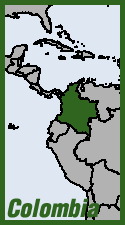 Colombia surpassed Peru last year in land under coca cultivation, resuming its number one position for the first time since 2012. The latest annual report from the UN Office on Drugs and Crime (UNODC) finds that territory under coca cultivation dropped 14% in Peru, from 49,800 hectares in 2013 to 42,900 to 2014—the smallest area under cultivation since 1998. Colombia meanwhile experienced a 44% jump from 48,000 hectares to 69,000. Peru made gains againt coca in the Upper Huallaga Valley, while coca fields expanded in Colombia's Putumayo, Caquetá, Meta and Guaviare regions—all on the frontier lands of plains and rainforest east of the Andes. The findings do not necessarily mean that Colombia is now the world's top cocaine producer, as much of Peru's crop is more mature and higher yielding, having never been subjected to eradication. While Peru eradicates in the Upper Huallaga, it resists US pressure to do so in a second coca cultivation zone, the Apurímac-Ene Valley, for fear of inflaming peasant unrest. (AP, UNODC, July 15; UNODC, July 2)
Colombia surpassed Peru last year in land under coca cultivation, resuming its number one position for the first time since 2012. The latest annual report from the UN Office on Drugs and Crime (UNODC) finds that territory under coca cultivation dropped 14% in Peru, from 49,800 hectares in 2013 to 42,900 to 2014—the smallest area under cultivation since 1998. Colombia meanwhile experienced a 44% jump from 48,000 hectares to 69,000. Peru made gains againt coca in the Upper Huallaga Valley, while coca fields expanded in Colombia's Putumayo, Caquetá, Meta and Guaviare regions—all on the frontier lands of plains and rainforest east of the Andes. The findings do not necessarily mean that Colombia is now the world's top cocaine producer, as much of Peru's crop is more mature and higher yielding, having never been subjected to eradication. While Peru eradicates in the Upper Huallaga, it resists US pressure to do so in a second coca cultivation zone, the Apurímac-Ene Valley, for fear of inflaming peasant unrest. (AP, UNODC, July 15; UNODC, July 2)
 Gerson Adair Gálvez Calle AKA "Caracol" (The Snail), Peru's most wanted fugitive drug lord, was arrested by Colombian National Police at a shopping center in Medellín and promptly deported on May 1. National Police director Gen. Jorge Hernando Nieto called the apprehension "a powerful shot against transnational crime." Peruvian authorities had offered a reward of $150,000 for information leading to the arrest of El Caracol, who is considered Peru's biggest exporter of cocaine.
Gerson Adair Gálvez Calle AKA "Caracol" (The Snail), Peru's most wanted fugitive drug lord, was arrested by Colombian National Police at a shopping center in Medellín and promptly deported on May 1. National Police director Gen. Jorge Hernando Nieto called the apprehension "a powerful shot against transnational crime." Peruvian authorities had offered a reward of $150,000 for information leading to the arrest of El Caracol, who is considered Peru's biggest exporter of cocaine.
 Another massive marijuana raid is reported from Peru's high Andean region of
Another massive marijuana raid is reported from Peru's high Andean region of 





Recent comments
2 weeks 6 days ago
3 weeks 6 days ago
4 weeks 11 min ago
5 weeks 2 days ago
10 weeks 3 days ago
12 weeks 6 days ago
18 weeks 25 min ago
29 weeks 6 days ago
32 weeks 9 hours ago
33 weeks 9 hours ago